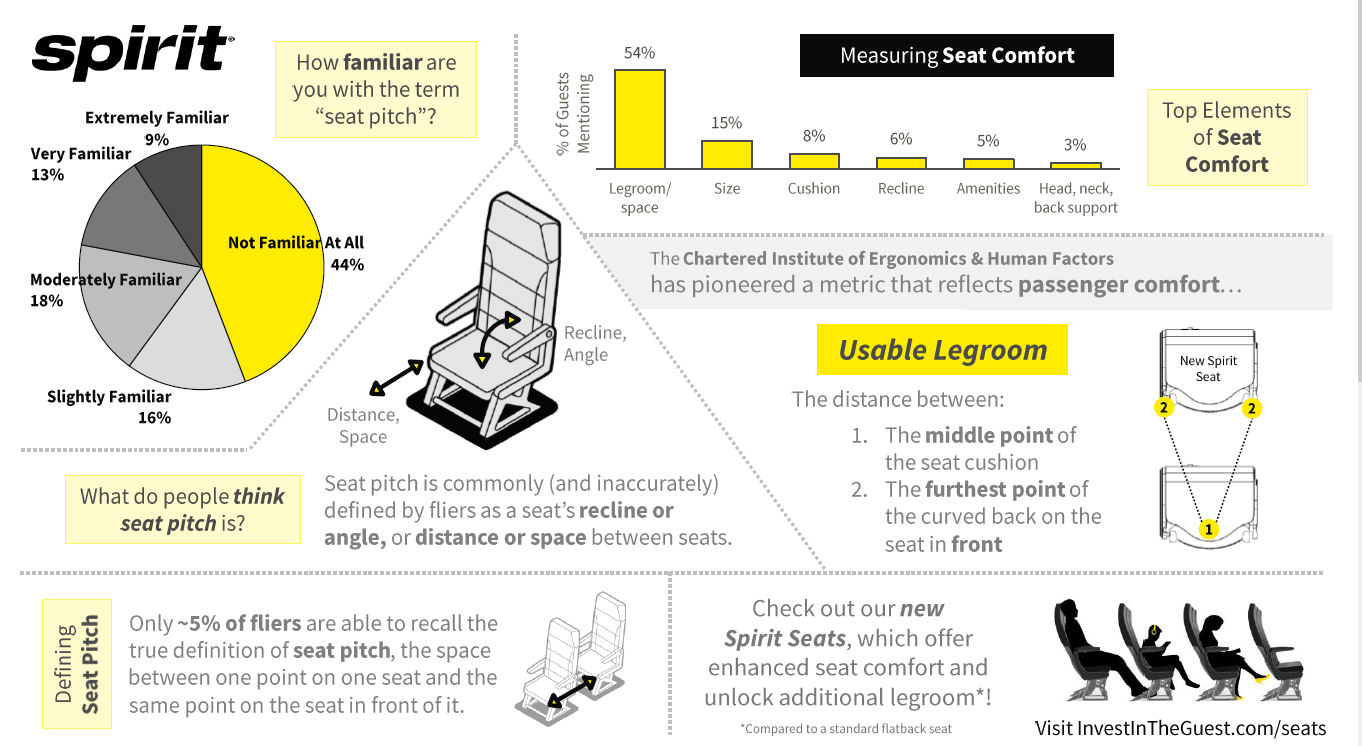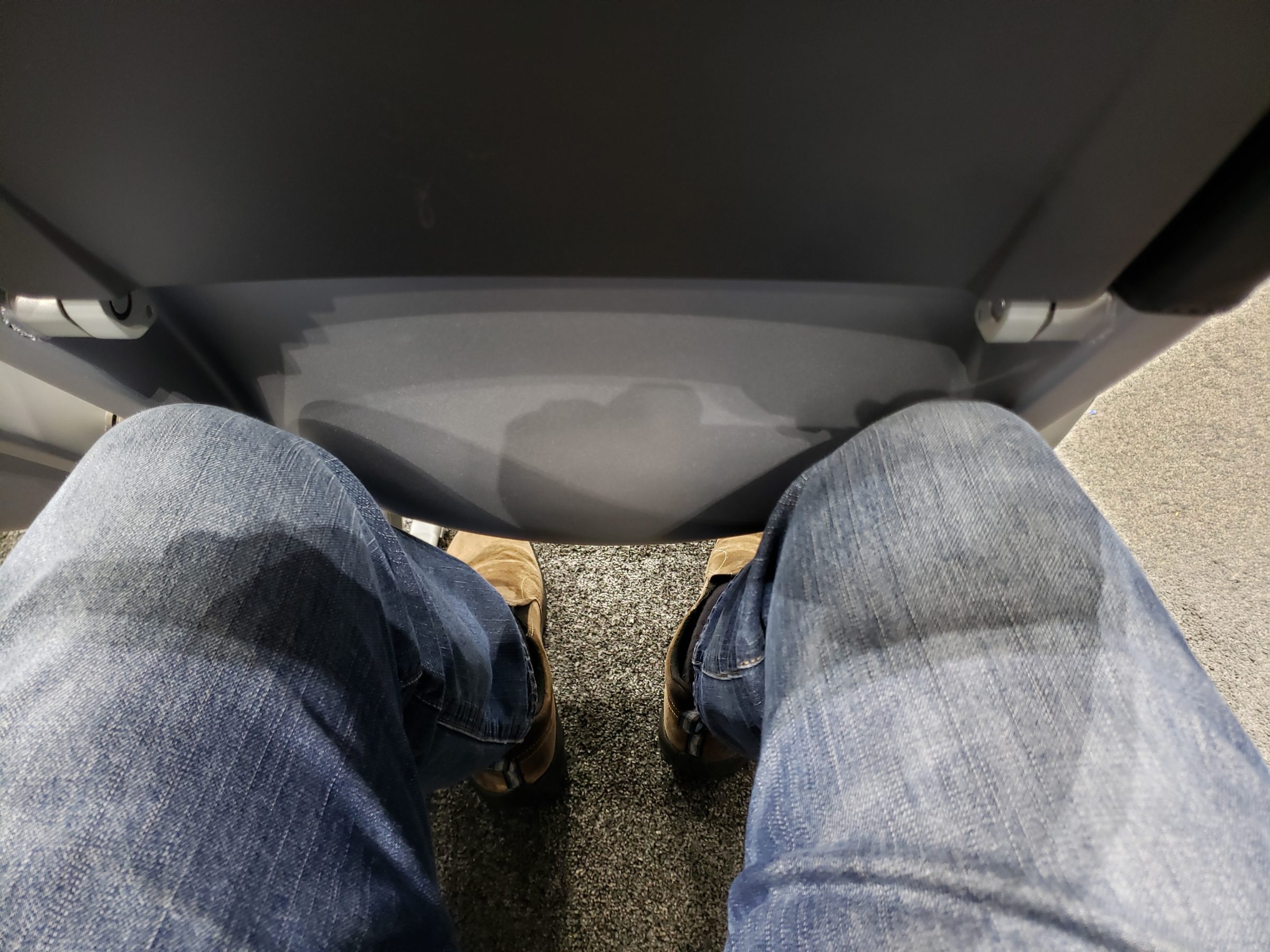Leeham News and Analysis
There's more to real news than a news release.
Pontifications: Spirit Air reveals new seats at Apex
Sept. 16, 2019, © Leeham News: Los Angeles—Spirit Airlines, a US ultra-low-cost carrier, is upgrading its passenger seating experience, the airline’s CEO announced last week at the Apex Expo 2019 event.
Ted Christie unveiled new designs for its Big Front Seat—Spirit’s version of First Class—and coach seats that are ergonomically designed and intended to add more room and redefine how seats are measured.
The Big Front Seat appears little different than the previous version—more padding seems to be the main feature.
But the changes to coach seating, where most people fly, are billed to have the potential to make a big difference compared with the ever-slimmer, increasingly uncomfortable seats offered by many suppliers and installed on most airlines.
Differences in design
The coach seats, by ACRO, a UK-based company, are more ergonomic and certainly more comfortable than some of the slim-line seats introduced years ago.
 The Spirit seats also do not have an adjustable recline but seem a better fit than other non-reclining designs in a test by this writer.
The Spirit seats also do not have an adjustable recline but seem a better fit than other non-reclining designs in a test by this writer.
But the all-important legroom doesn’t quite live up to the billing when Christie unveiled the seats before a large crowd of Expo delegates.
The seat’s frame still interferes with leg positioning that is not closed and the bulge in the seat back—making space for the rear end of the passenger in front of you—tends to eat into knee room.
When legs are stretched underneath the seat in front, these problems are solved. But on long flights, where shifting positions are needed for comfort, isometrics or DVT avoidances, the 28-inch seat pitch still seems like 28 inches, though Christie said the space is the equivalent to 30-inches.
Redefining space
This brings us to the topic of redefining “pitch” and “space.”
Christie said 44% of passengers surveyed didn’t know the term and only 5% could correctly recite the definition. All others fell in between Very Familiar or Slightly Familiar with the term.
Christie said the industry should talk about useable space and comfort space.
This isn’t a new concept. Embraer began talking about total passenger space when it introduced the E-Jet in 2004. Bombardier and now Mitsubishi placed emphasis on passenger space with the C Series (now the Airbus A220) and SpaceJet, respectively.
Christie’s other feature touted last week: a wider middle seat.
The new coach seats are 17 inches wide for the aisle and window seats and 18 inches for the center seat.
However, the normal Airbus seat width is 18 inches for each.
Spirit takes two inches away from the three-seat row and makes a wider aisle, a plus.
But by going to 17 inches, the window and aisle seats on Spirit’s Airbus A320s are narrower than the 17.3 inches on the Boeing 737, a long-standing complaint where passengers become shoulder-scrunched.
One report about the new seating said Spirit would charge more for the wider center seat.




If Christie thinks these changes will allow Spirit pilots to take the anonymizing brown paper bags off their heads when they’re at the airport and walking through the terminal, he’s sadly mistaken. (LOL)
@Montana Osprey
Buhahhahajejeje 😂 good point!
Sadly squeezing more and more pax will not help. Those supposedly ergonomic seats doesn’t seem so ergonomic.
Not sure what the pilots have to do with the corporate decision to fit more sardines in the can.
Luckily I don’t have to fly with them. It’s getting worse and worse.
And I’m always wary when new concepts are introduced, to explain how a worse product should actually be superior. That’s very creative marketing here.
I love the fact that Spirit is redesigning their seats. I think it is a very positive thing and, many airlines should be more like them. Way to fly Spirit
Blood clots are a real risk. Thank you for mentioning DVT.
“But on long flights, where shifting positions are needed for comfort, isometrics or DVT avoidance…”
With additional knee/legroom available only at opposite sides of the curved seat-backs in the row ahead of each seat (other than the bulkhead), not to mention that the seats 17” width of the aisle and window seats which to this commenter who is hardly tall or broad shouldered, but who’s width between shoulders measures at 19” are unbearably narrow for flights of any length, it will be interesting to see how the spreading of one’s legs to gain the additional personal space legroom plays out in the real world instead of whatever simulations have been done by the seat manufacturer or the airline?
I say this as a longtime New York City mass transit rider, who has encountered the unpleasantness we call “Man-Spreading”, which is when males spread their legs as wide as possible when seated, who are selfish (and to some, women especially, creepy) space hogs.
And that’s for males; NOT sure how women will feel about having to spread their legs to the opposite sides of their own seats in order to escape the prison cell-like confinement of Spirit’s torturous, DVT-risk inducing, 28” pitch rows at the centermost portion of the new seats in the rows ahead of them on Spirit’s sadistic flying torture tubes?
I guess we shall see in 2 or so months’ time.
But for those who typically travel solely in the comfort of their own private vehicles for transportation, and have no concept of what “Man-Spreading” is in general terms, or more importantly, how offensive many women find that to be when encountered on a subway, bus or commuter train, I’m wondering if these curved seats, and the need to spread one’s legs far and wide to gain a smidgen of additional legroom (which, of course, when flying even a smidgen of additional legroom and personal space matters – a LOT) isn’t going to have a head-on collision with the reality of “Man-Spreading” (or some other unintended negative impacts for women when they’re faced with the choice of cramped quarters for an entire flight versus spreading their legs to the outermost opposite sides of their seats to gain relief from 28” row pitch)?
I’m NOT sure this “idea” will fly as well in the real world as it might seem in concept.
That’s the beauty of the markets, one gets to choose who they want to fly with.
Ostensibly, it seems Spirit Airlines is doing ok in the USA-thus there are more than enough travelers who don’t mind giving them business.
YMMV.
That assumes the is more than one choice for where you are trying to go from and to.
And it is not a given for any specific passenger.
While I have broad shoulders, leg room is what I want the most (if I have to give up and shoulder width has been fixed since I got those wide shoulders you many years ago – not flying wide body that often)
I think we should just go with lawn chairs.
At this point those ‘standing’ positions that Ryan Air was proposing is beginning to make sense. Its only 463km London to Dublin. Surely standing is better than sitting? Thomas Jefferson wrote the constitution standing.
At a Desk, the first of the latest rage of standing at your desk and pretending to work (well he did)
Arco seats are in use mainly in ATRs, for example with the Notes/Finnair fleet. These are just another kind of slim line seat. Nothing special and equally horrid.
I did more international traveling than usual this year and was struck by how much room there still is in coach on international airlines. As someone who’s six and a half feet tall, I agree that whether it’s smaller space between seats or creative marketing, there’s only so much that can be done tweaking the ergonomic design as though airlines hadn’t already exhausted the potential seat designs on their plane. https://www.ashworthcreative.com/